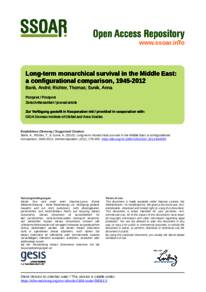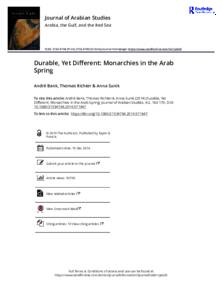وثيقة
Long-term monarchical survival in the Middle East : a configurational comparison,1945–2012.
المعرف
DOI: 10.1080/13510347.2013.845555
المساهمون
Richter, Thomas., مؤلف
Sunik, Anna., مؤلف
الناشر
Routledge.
ميلادي
2015-01
اللغة
الأنجليزية
الملخص الإنجليزي
The survival of eight monarchies during the "Arab Uprisings" has put centre stage the fundamental question about the durability of this subtype of authoritarian regime. Seen from a broader historical perspective, however, the idea that monarchies have an inherent advantage in retaining power is less evident: a number of authoritarian monarchies broke down and subsequently became republics (Egypt 1952, Iraq 1958, North Yemen 1962, Libya 1969, Iran 1979), while others survived (Bahrain, Jordan, Kuwait, Morocco, Oman, Qatar, Saudi Arabia, United Arab Emirates). To account for these divergent long-term pathways we systematically compare the 13 current and former Middle East monarchies. Using a fuzzy set qualitative comparative analysis (fsQCA), we concentrate on five central explanatory factors derived from previous research – namely, external support, rent revenues, family participation, the monarch's claim to legitimate rule, and hard repression. Our findings highlight the existence of three broad pathways to monarchical survival – linchpin monarchies, like Jordan and Morocco, versus the dynastic Gulf monarchies – and also reveal a possible hybrid third pathway, one which shares linchpin characteristics, but relates to cases on the Arabian Peninsula (Oman and the historical Imamate in North Yemen).
المجموعة
ISSN
1351-0347
URL المصدر
قالب العنصر
مقالات الدوريات


